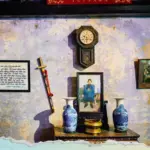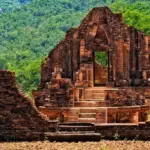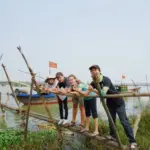My Son Sanctuary: History and Significance of the Champa Ruins by Ovuigo
My Son Sanctuary, nestled in Quang Nam Province of Vietnam, is a hauntingly beautiful archaeological site that carries the deep imprint of the Champa civilization. Recognized as a UNESCO World Heritage Site, this forgotten valley of ancient ruins lies about 40 kilometers from Hoi An Ancient Town and stands as a gateway to understanding the spiritual and political nucleus of the Champa Kingdom from the 4th to the 13th century. The temples here, encircled by dense forest and dramatic mountains, once echoed with religious ceremonies honoring Hindu deities brought through Indian influence to Greater Indochina. My Son’s significance extends beyond local heritage; it is a rare vestige of Southeast Asia’s Hindu past—symbolized by its lotus flower motifs, incense stick rituals, and intricate temple icons.
During the Champa reign, My Son functioned as both a spiritual heartland and a royal burial ground. This status brought considerable architectural and religious development, setting My Son apart from other Vietnamese archaeological sites. Today, visitors walk amid temple clusters, crumbling red brick towers, and outlined sanctuaries—silent witnesses to centuries of cultural, religious, and dynastic transformations. The site’s UNESCO status not only marks it as an asset of universal value but also ensures ongoing preservation efforts, crucial for future generations. The ancient ruins of My Son invite you to witness the convergence of history, mythology, and a living legacy that connects Quang Nam Province with the broader history of Southeast Asia.
Find My Son Sanctuary on Google Maps

Champa Civilization and Hindu Temples: Architectural Highlights
Step into My Son and you are instantly surrounded by the unique architecture of the Champa temples, the crowning achievement of ancient Vietnamese history in Quang Nam. Built primarily using locally-sourced red bricks held together by a secret Cham mortar, these temple ruins exemplify the artistry of the Champa civilization. Each structure was crafted to honor Hindu gods—most notably Shiva—through both form and spatial layout. Elements of Indian influence are omnipresent: the temple complex is organized according to cardinal directions, housing linga-yoni symbols and adorned with stone reliefs depicting deities, dancers, and mythical animals.
The rare attributes of My Son’s architecture include brick compositions resilient to the ravages of time, Cham inscriptions detailing victories and offerings, and Cham sculpture art reflecting the synthesis of Indian and Southeast Asian aesthetics. The temples’ rooflines swoop upwards like the mythical Mount Meru, visually linking earth and heaven—a deliberate religious overlap for visitors interested in spiritual sites in Vietnam. The cluster of temples and towers, once plastered and vibrantly painted, now stand weathered yet dignified. As you examine the ancient brickwork, notice the precision in every joint—an engineering feat few modern cities can replicate. Visitors can spot the famous UNESCO logo sign marking the entrance, emphasizing the protected status that distinguishes My Son from once-destroyed or unprotected sites elsewhere in Southeast Asia.
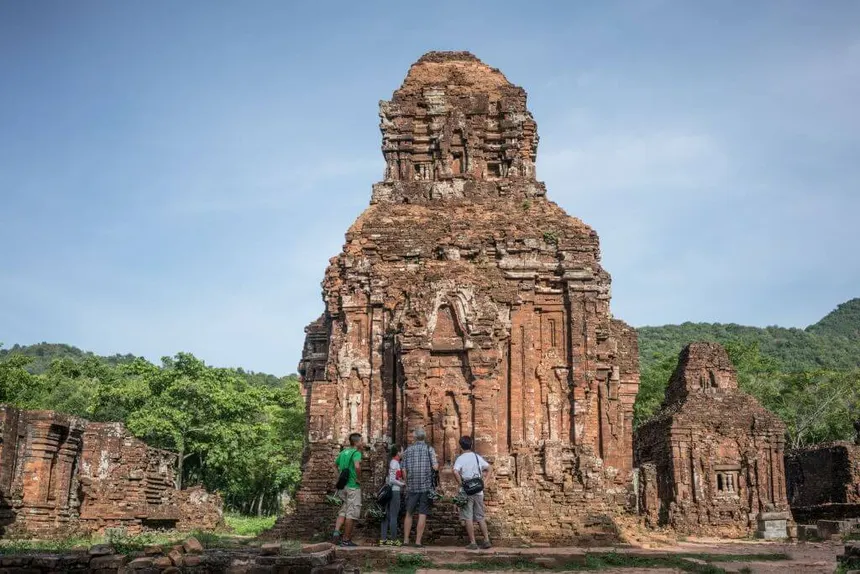
How to Travel from Hoi An to My Son Sanctuary
Traveling from Hoi An to the tranquil valley of My Son is straightforward, practical, and suited to a range of budgets. The Sanctuary is located only 40 kilometers northwest of Hoi An, making it an ideal target for a morning or afternoon day trip. The easiest and most comfortable option is booking a Hoi An to My Son private transfer through reputable local services such as ovuigo, ensuring door-to-door convenience. Those seeking adventure may rent a motorbike, following the scenic route that traces the Thu Bon River, winds through lush countryside, and passes smaller Cham sites near Tra Kieu. For budget travelers, daily buses depart from Hoi An’s main bus station to My Son, usually coordinated with the site’s opening schedule.
My Son also sits within an hour’s drive from Da Nang and near the stunning Marble Mountains, allowing you to combine visits to other major heritage attractions. If you’re aiming for a practical My Son Hoi An day trip itinerary, start early to catch cooler weather, beat the crowds, and then detour toward Da Nang or the Marble Mountains by midday. For precise navigation, set your destination to My Son Sanctuary on Google Maps to avoid confusion with other locations. For personal or family groups, WhatsApp ovuigo (+84868319161) for up-to-date transfer options, and reliable, English-speaking support.

Visitor Information: Opening Hours, Tickets, and Best Time to Visit
My Son Sanctuary opens its sacred doors daily from 6:00 AM to 5:00 PM, allowing ample time for exploration in comfort. Admission for international visitors is 150,000 VND (approximately 6.5 USD), which includes full access to the archaeological site, an on-site museum, occasional Cham dance performances, and electric buggy transfer from the entrance gate. Tickets are obtainable at the main entrance or can be reserved through trusted partners like ovuigo for hassle-free entry.
Facilities on site include shaded rest stops, local eateries, public restrooms, and a small gift shop with Cham art reproductions. Aim to visit from February to April or again in September, seasons that bless Central Vietnam with mild temperatures and lower rainfall. Arriving early in the morning guarantees the best light for photography and the quietest atmosphere among the ancient ruins. Mark your calendar for annual events and cultural celebrations, which often coincide with Vietnamese public holidays and bring traditional Cham rituals to life whether you are alone or on a cultural tour. For rapid support, consult local experts or reach out via WhatsApp (+84868319161) for real-time tips on the best visiting times and crowd conditions.

Preservation, Restoration, and Wartime History of My Son Sanctuary
My Son’s ancient beauty belies a turbulent history. Regular restoration projects strive to reverse the effects of time, climate, and war-related destruction. Decades of regional conflict, especially aerial bombings during the Vietnam War, left several temple complexes in ruins—reminders of both resilience and loss. International cooperation with UNESCO and governmental agencies has brought conservation expertise, funding, and innovative methods to stabilize the rare attributes such as unique brickwork and sacred architecture.
Restoration teams, including experts from Vietnam, Italy, and India, work with local Cham communities to safeguard excavation findings and perform religious ceremonies that honor the site’s spirit. Visitors may notice ongoing construction or restricted access to certain temple groups—evidence of these preservation efforts. The balance between allowing public access and fully protecting this unique cultural asset presents ongoing challenges. As a living archaeological site, My Son continues to yield new discoveries and reveal additional layers of the Champa civilization, enhancing its value as a world-class heritage and Vietnamese national treasure.
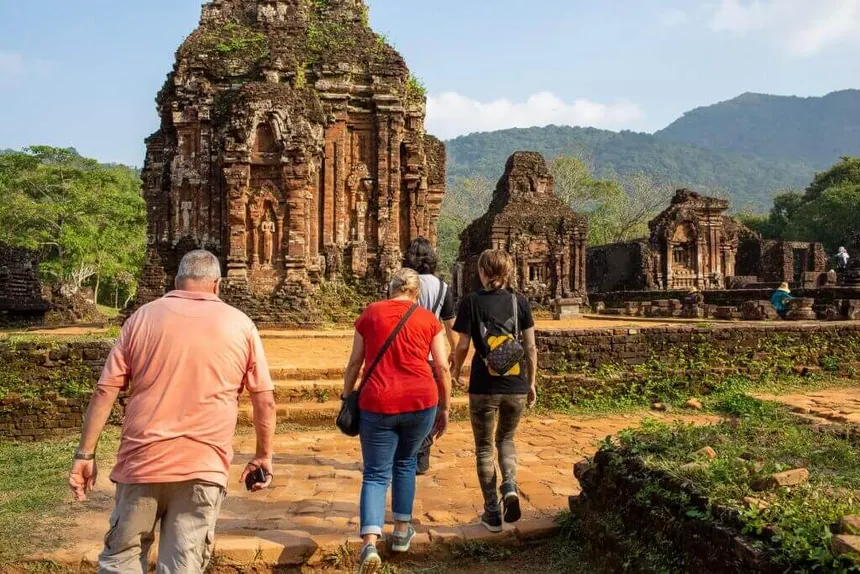
Experiencing My Son: Cultural Tours, Events, and Nearby Attractions
A visit to My Son transcends simple sightseeing—it is a journey into the heart of Vietnam’s cultural memory. Guided tours run daily and are highly recommended for those wanting to understand the complexities of Champa religion, art, and history. Ovuigo offers insightful packages, including My Son Sanctuary history tours, private transfers, and tailored itineraries that link with Hoi An Ancient Town and Da Nang heritage sites.
Cultural activities abound: look out for the annual Cham festival each summer, where you can witness traditional music, dance, and religious rites practiced by present-day descendants of the Champa people. To build a memorable My Son Hoi An day trip itinerary, start at My Son, pause for lunch along the Thu Bon River, then journey back to Hoi An for an evening exploring lantern-lit streets. If time allows, a detour to Marble Mountains or the historic town of Tra Kieu adds a new dimension to your discovery of Quang Nam. For current tours or tailored experiences, connect with local travel experts via WhatsApp at (+84868319161) for rapid booking and advice.
If you plan a stay in Hoi An, check out The Manor Hoi An, Hola 1, and Hola 2 for some of the area’s most welcoming and comfortable accommodations—perfect bases for launching your journey into the heart of Vietnam’s cultural heritage.

